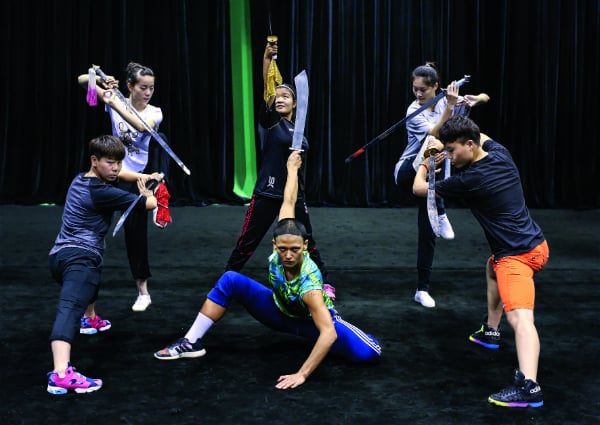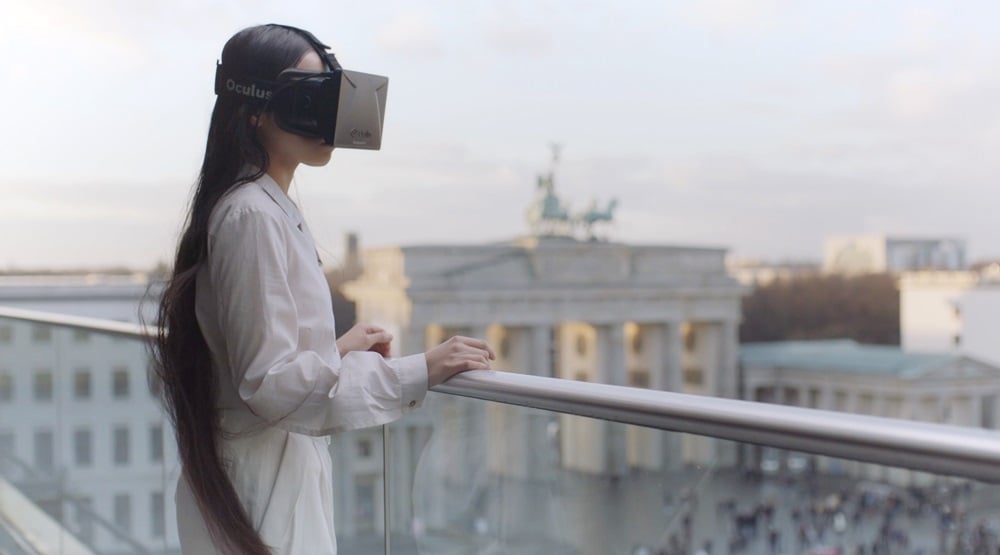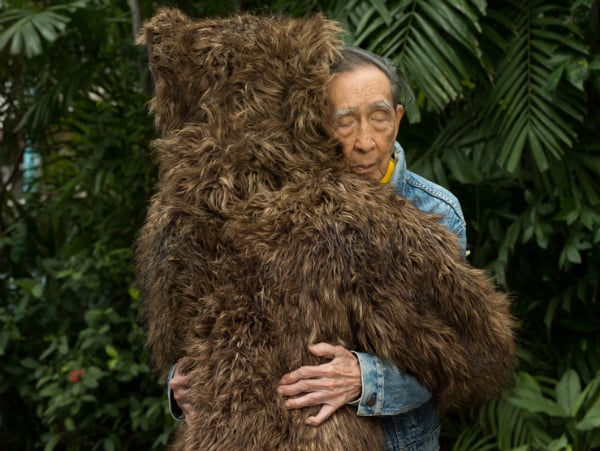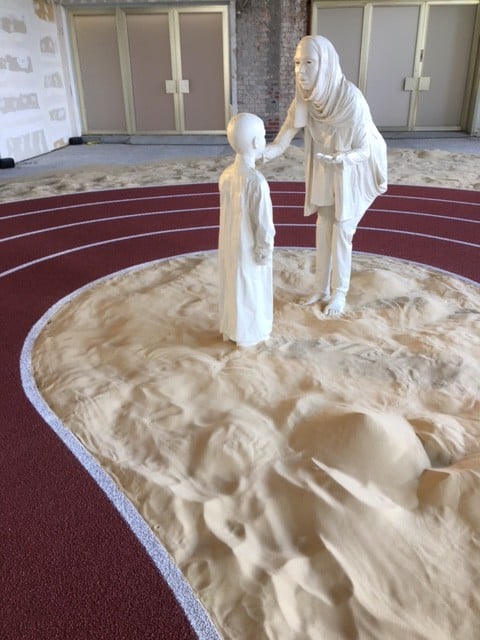Galleries
The 9th Berlin Biennale Revels in Doomsday Scenarios and Secret Spaces
The highly-anticipated show puts a soft focus on hot topics.

The highly-anticipated show puts a soft focus on hot topics.

Hili Perlson

The 9th Berlin Biennale (bb9), which opens its doors to the public tonight, is perhaps the most highly anticipated event Berlin has seen in recent years. Ever since the announcement, in 2014, that DIS collective will curate the exhibition initiated some 20 years ago by Klaus Biesenbach, any speculations about their curatorial concept were uttered mostly with an “ugh, post-Internet” eye-roll, but one that always ended on a distinctive tone of excited optimism. This duality befits the exhibition.

Berlin Biennale, Speculative Ambience (2016). Courtesy Berlin Biennale für zeitgenössische Kunst / for Contemporary Art.
As DIS explained, “The Present in Drag” looks at the inconsolable contradictions that characterize our present, and the inconsistencies that plague the choices we make in our daily lives. Add to that conceit a curatorial team that highlights such questions as private vs. public, corporate culture and the optimized self, or happiness as GDP, then dramatizes them, dresses them up, and sends them performing (rather than, say, shake a finger at the wrongs of the world), and you’ll end up with a new set of questions about the very nature of art.
In the bb9, one thing it can certainly be is products. To start off, there’s a variety of merchandise visitors can buy, from a collection designed by TELFAR—a brand that is “neither conceptual nor accessible”—to a pair of Hater Blocker contact lenses designed by artist Yngve Holen.
There’s also Anthem, the official soundtrack for the biennial, which can be yours as a limited edition of vinyl singles released throughout the duration of the show, with collaborative tracks by artists and musicians, such as Isa Genzken and Total Freedom. Collect them all.
https://instagram.com/p/BGJehO0mZpM/?tagged=bb9
But there are consumer products on view outside the well-designed gift shop-cum-concept store which are presented as artworks. Artist Débora Delmar Corp. is pushing a green juice called MINT, which questions how aspirational health food trends collide with the pitfalls of the global fruit trade. Around the bottled concept, DD Corp has built a juice bar, complete with upcycled furniture and sculptures made of lettuce, watermelon, and wheat-grass infused plaster casts to drive home her point about “greenwashing.” This demonstration runs parallel to Sean Raspet’s presentation of the food replacement product Soylent at this year’s edition of Frieze New York, which doubled as a trade fair-style promotional booth for the food start-up Raspert also works for. At bb9, a translucent version of the liquid is sold together with the catalog.
Nearby, a bed doubles as a watching platform for a video by the roving artist-run M/L Artspace, and a display for the line of bedding they’d produced for the biennale, emblazoned with texts by critic Andrew Russeth and dedicated to three years of one-night shows staged in temporary places across New York.
Other products feel less like stand-ins for bigger ideas and more like realities within reach. For instance, artist Trevor Paglen collaborated with hacker and computer security researcher Jacob Appelbaum (who some might remember from Laura Poitras’s award-winning film Citizenfour) to create Autonomy Cube, a “useable sculpture” that is a router for the anonymous internet software Tor. The room where the piece is installed becomes a secure, anonymous hotspot, with the hardware that enables internet freedom at its heart.
One work that will surely be remembered as a highlight of the biennale is located at the Akademie der Künste (ADK), which is situated by the Brandenburg Gate. Jon Rafman created a three-minute Oculus Rift experience that viewers can find on the storied building’s balcony. The work recreates the view from the balcony, looking over the Pariser Platz, but after a disorienting few moments where everything looks the same, a doomsday scenario start to unfold, and the sculptures of hybrid creatures scattered around the balcony come to life.
With their choice of locations, DIS intended to force interactions between the art world and the steady stream of tourists that fill Berlin in the summer; on preview day, there was a political demonstration at Brandenburg Gate, and tourist groups taking selfies where the Berlin Wall used to run, while the smell of nearby carriage horse droppings filled the hot summer air. To follow the curators’ metaphor, if the present is in drag, the clothes it dons are designer rip-offs scavenged from a landfill.

Korakrit Arunanondchai & Alex Gvojic, There’s a word I’m trying to remember, for a feeling I’m about to have (a distracted path towards extinction), (2016). Courtesy of the artists.
In these heady summer days, it’s hardly surprising that several artists deal with climate change and extinction in their works. For instance, Korakrit Arunanondchai and Alex Gvojic collaborated on a boat that takes a touristic route along the river, with unexpected results.
On the upper deck, the two created an environment that will serve as a stage for performances, while downstairs, a captivating film examined the possibility of human extinction, and a future in which giant rats will roam the earth. In one scene, a sage human-sized rat tries to communicate with an elder human, and the pain in its screeching voice conveys immense tragedy (the film also features the enigmatic artist boychild, who will perform on the upper deck, and who also appears in several other works by bb9 artists).
Over at the KW location, artist Cecile B. Evans postulates a different outcome, namely the replacement of humans by digital identities, which is in one form or another already underway. The video work is presented in an impressive environment that occupies an entire floor at KW and appears as if it were submerged in water, with only a narrow platform for viewers to stand on. However, Evans’s human-less future is not nearly as chaotic as Arunanondchai and Gvojic’s, with its compelling machine-designed geometries.
The battlefield on which these futures might be determined is the human body, and many works visit it as a theme. Anna Uddenberg’s figures, part-human, part-cargo, and at times, part architectural elements, do so with a refined mix of humorous yet critical observations about taste and class, sexual attractiveness, and socially scripted behavior. For instance, there’s a figure doing the splits in front of a mirror, while another one takes an intimate selfie. As these poses are Instagram standards, the sculptures in which the sexualized female bodies are twisted to merge with suitcases will be remembered as the more timeless works in this series.
Here, many artists check various boxes relating to self-optimization. Nik Kosmas, formerly of AIDS 3D, even offers workout sessions on a multi-colored jungle gym he had constructed. But others look at the sensuality and physicality of differently abled bodies.
For instance, in Happy Museum (2016), Simon Fujiwara collaborated with his brother Daniel, an economist specializing in quantifying happiness, on a museum-like display of objects that enhance the lives of Berlin citizens. One of the first objects on view is the door of a brothel that specializes in catering to disabled clients. In their work Army of Love (2016), Alexa Karolinski and Ingo Niermann campaign for the utopian idea of desire that is free of commodification. Among the film’s characters, we also see disabled men and women discussing their sexuality, caressing, and being touched.
That human interactions are quantified and monetized is also a theme for works dealing with the sharing economy, or with the fair booths created by Simon Denny and Linda Kantchev, for real companies, in the installation Blockchain Visionaries (2016). Presented in the European School of Economics, which is housed, ironically, in the former building of the East German State Council—a largely untouched Communist monument—the work looks at companies who are devising ways to turn various forms of data exchange into cryptocurrency.

GCC, Positive Pathways (2016). Courtesy of the author.
Keeping with the theme of the economy of happiness, the collective GCC surprises with a large-scale room installation, as opposed to another eye-numbing video work. The installation takes its cue from the recent creation of Dubai’s first-ever Minister of Happiness, acknowledging a new-agey culture of optimism that has emerged in the Persian Gulf region. The work depicts a female figure speaking to a child, where the two figures are positioned underneath stage lights, with a running track looping around them in a shape suggestive of calligraphy. A female voice explains the child how positivism will ameliorate their chances at success and social status.
Needless to say, there’s a lot more intriguing mind games going on at the bb9 that are worth exploring. For one, LIT is a section of the biennial where an excellent list of artists created captivating backlit posters that adopt the visual language of advertising. There’s a plethora of video works on view by the most recognizable names of this generation, including Wu Tsang, Ryan Trecartin/Lizzie Fitch, and Amalia Ulman.
However, if DIS set out to mine present-day contradictions, its biennale also offers a view of the inconsistencies in artists’ approaches to placing their work within that very slippery context, with some participants falling into traps. This might have to do with the fact that, here, the present isn’t shaped by realpolitik or visible issues like the European immigrant crisis. The powers that be are abstract, immaterial, and cast us—as a society—as passive, if well-informed, consumers.
The 9th Berlin Biennale takes place from June 4 – September 18. Check the program for information about upcoming performances.